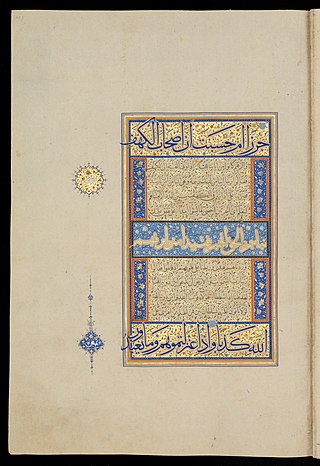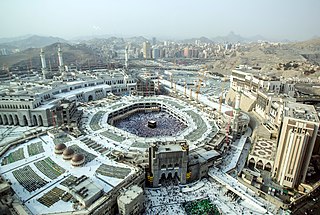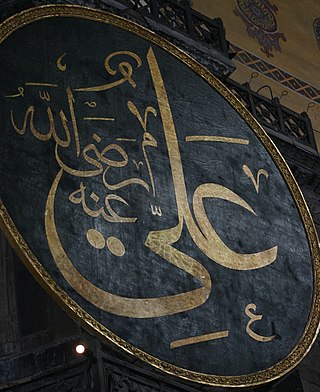| Quran |
|---|
This is a list of things mentioned in the Quran. This list makes use of ISO 233 for the Romanization of Arabic words. [1]
Malāʾikah (مَلَائِكَة, Angels):
Jinn :
Shayāṭīn (Arabic : شَيَاطِيْن, Demons or Devils):
Prophets (Arabic : أَنۢبِيَاء, anbiyāʾ) [lower-alpha 3] or Messengers (رُسُل, rusul) [lower-alpha 4]
"Those of the Perseverance and Strong Will" (Arabic : أُولُو ٱلْعَزْم, romanized: ʾUlu al-ʿAzm) [lower-alpha 8] in reverse chronological order:
Aʿdāʾ (Arabic : أَعْدَاء, Enemies or foes), aṣḥāb (Arabic : أَصْحَاب, companions or friends), qurbā (Arabic : قُرْبَى, kin), or followers [lower-alpha 10] of Prophets:
Ajwa (عجوة) is a soft dry variety of date fruit from Saudi Arabia
Ajwa (عجوة) is a soft dry variety of date fruit from Saudi Arabia
Fawākih (Arabic : فَوَاكِه) [lower-alpha 21] or Thamarāt (Arabic : ثَمَرَات): [104] [lower-alpha 22]
Shajar (Arabic : شَجَر, [20] Bushes, trees or plants): [lower-alpha 24]
Maṣābīḥ (Arabic : مَصَابِيْح, [108] [109] literally 'lamps'):
12 months:
Times for Duʿāʾ ('Invocation'), Ṣalāh and Dhikr ('Remembrance', including Taḥmīd ('Praising'), [115] [116] Takbīr and Tasbīḥ ):

Mecca is the capital of Mecca Province in the Hejaz region of western Saudi Arabia and the holiest city in Islam. It is 70 km (43 mi) inland from Jeddah on the Red Sea, in a narrow valley 277 m (909 ft) above sea level. Its last recorded population was 2,385,509 in 2022. Its metropolitan population in 2022 is 2.4 million, making it the third-most populated city in Saudi Arabia after Riyadh and Jeddah. Around 44.5% of the population are Saudi citizens and around 55.5% are foreigners from other muslim countries. Pilgrims more than triple the population number every year during the Ḥajj pilgrimage, observed in the twelfth Hijri month of Dhūl-Ḥijjah.
Al-Ikhlāṣ, also known as the Declaration of God's Unity and al-Tawhid, is the 112th chapter (sūrah) of the Quran.

Al-Kahf is the 18th chapter (sūrah) of the Quran with 110 verses (āyāt). Regarding the timing and contextual background of the revelation, it is an earlier Meccan surah, which means it was revealed in Mecca, instead of Medina.

Safa and Marwa are two small hills, connected to the larger Abu Qubais and Qaiqan mountains, respectively, in Mecca, Saudi Arabia, now made part of the Masjid al-Haram. Muslims travel back and forth between them seven times in what is known as saʿī ritual pilgrimages of Ḥajj and Umrah.
An-Naml is the 27th chapter (sūrah) of the Qur'an with 93 verses (āyāt).
Ahl al-Bayt refers to the family of the Islamic prophet Muhammad, but the term has also been extended in Sunni Islam to all descendants of the Banu Hashim and even to all Muslims. In Shia Islam, the term is limited to Muhammad, his daughter Fatima, his cousin and son-in-law Ali ibn Abi Talib, and their two sons, Ḥasan and Husayn. A common Sunni view adds the wives of Muhammad to these five.

Muzdalifah is an open and level area near Mecca in the Hejazi region of Saudi Arabia that is associated with the Ḥajj ("Pilgrimage"). It lies just southeast of Mina, on the route between Mina and Arafat.

The holiest sites in Islam are predominantly located in the Arabian Peninsula and the Levant. While the significance of most places typically varies depending on the Islamic sect, there is a consensus across all mainstream branches of the religion that affirms three cities as having the highest degree of holiness, in descending order: Mecca, Medina, and Jerusalem. Mecca's Al-Masjid al-Haram, Al-Masjid an-Nabawi in Medina and Al-Masjid al-Aqsa in Jerusalem are all revered by Muslims as sites of great importance.
Ahl al-Kisa, also known as the Al al-Aba, are the Muhammad the Islamic prophet, his daughter Fatima, his cousin and son-in-law Ali, and his two grandsons Hasan and Husayn.

The Kaaba, sometimes referred to as al-Ka'ba al-Musharrafa is a stone building at the center of Islam's most important mosque and holiest site, the Masjid al-Haram in Mecca, Saudi Arabia. It is considered by Muslims to be the Bayt Allah and is the qibla for Muslims around the world. The current structure was built after the original building was damaged by fire during the siege of Mecca by Umayyads in 683.

Both Sunni Muslims and Shia Muslims agree on the three Holiest sites in Islam being, respectively, the Masjid al-Haram, in Mecca; the Al-Masjid an-Nabawi, in Medina; and Al-Masjid al-Aqsa, in Jerusalem.
Islam is an Abrahamic monotheistic religion teaching that there is only one God (Allah) and that Muhammad is His last Messenger.

Lists of mosques cover mosques, places of worship for Muslims. The lists include the most famous, largest and oldest mosques, and mosques mentioned in the Quran, as well as lists of mosques in each region and country of the world. The major regions, Africa, Americas, Asia, Europe and Oceania are sorted alphabetically. The sub-regions, such as Northeast and Northwest Africa in Africa, and Arabia and South Asia in Asia, are sorted by the dates in which their first mosques were reportedly established, more or less, barring those that are mentioned by name in the Quran.
Prophets in Islam are individuals in Islam who are believed to spread God's message on Earth and serve as models of ideal human behaviour. Some prophets are categorized as messengers, those who transmit divine revelation, most of them through the interaction of an angel. Muslims believe that many prophets existed, including many not mentioned in the Quran. The Quran states: "And for every community there is a messenger." Belief in the Islamic prophets is one of the six articles of the Islamic faith.
People of Ya-Sin or Ashab al-Qarya is the phrase used by Muslims to refer to an ancient community that is mentioned in the 36th surah of the Quran as the People of the City or the Companions of the City. The location and people of this city has been the subject of much scholarly debate in Islam.

Masjid al-Haram, also known as the Sacred Mosque or the Great Mosque of Mecca, is a mosque enclosing the vicinity of the Kaaba in Mecca, in the Mecca Province of Saudi Arabia. It is among the pilgrimage sites associated with the Hajj, which every Muslim must perform at least once in their lives if able. It is also the main site for the performance of ʿUmrah, the lesser pilgrimage that can be undertaken any time of the year. The rites of both pilgrimages include circumambulating the Kaaba within the mosque. The Great Mosque includes other important significant sites, such as the Black Stone, the Zamzam Well, Maqam Ibrahim, and the hills of Safa and Marwa.
People of the Ditch is a story mentioned in Surah Al-Burooj of the Qur'an. It is about people who were thrown into a ditch and set afire, due to their belief in Allah.

Ali in the Quran collects the verses of the Quran, the central religious text of Islam, which are said to have been revealed about Ali ibn Abi Talib, the cousin and son-in-law of the Islamic prophet Muhammad. Ali played a pivotal role during the formative years of Islam and is recognized as the fourth Rashidun caliph in Sunni Islam and the first imam in Shia Islam. Perhaps the most controversial such verse is 5:55, also known as the verse of walaya, which gave Ali the same spiritual authority as Muhammad, according to the Shia.
Ibn al-'Arabi uses no less than twenty-two different terms to describe the various aspects under which this single Logos may be viewed.
The kingdom of Saba is known to have existed in the region of Yemen. By 1000 BC caravan trains of camels journeyed from Oman in south-east Arabia to the Mediterranean. As the camel drivers passed through the deserts of Yemen, experts believe that many of them would have called in at Marib. Dating from at least 1050 BC, and now barren and dry, Marib was then a lush oasis teeming with palm trees and exotic plants. Ideally placed, it was situated on the trade routes and with a unique dam of vast proportions. It was also one of only two main sources of frankincense (the other being East Africa), so Saba had a virtual monopoly. Marib's wealth accumulated to such an extent that the city became a byword for riches beyond belief throughout the Arab world. Its people, the Sabeans - a group whose name bears the same etymological root as Saba - lived in South Arabia between the tenth and sixth centuries BC. Their main temple - Mahram Bilqis, or temple of the moon god (situated about three miles (5 km) from the capital city of Marib) - was so famous that it remained sacred even after the collapse of the Sabean civilisation in the sixth century BC - caused by the rerouting of the spice trail. By that point the dam, now in a poor state of repair, was finally breached. The irrigation system was lost, the people abandoned the site within a year or so, and the temple fell into disrepair and was eventually covered by sand. Saba was known by the Hebrews as Sheba [Note that the collapse of the dam was actually in 575 CE, as shown in the timeline in the same article in the History Files, and attested by MacCulloch (2009)].
With thousands of Hajjis, most of them in motor vehicles, rushing headlong for Muzdalifah, the potential is there for one of ... There is special grace for praying at the roofless mosque in Muzdalifah called al-Mash'ar al-Haram (the Sacred Grove) ...
It was still dark when we arrived at Muzdalifah, four miles away. The Koran instructs us to spend the night at al-Mash'ar al-Haram. the Sacred Grove at Muzdalifah, as one of the conditions for the hajj . We scrambled out of the bus and looked ...
The Qur'an admonishes: "When you hurry from Arafat, remember God at the Sacred Grove (al-mash' ar al-haram)," that is, at Muzdalifah (2:198). Today a mosque marks the place in Muzdalifah where pilgrims gather to perform the special saldt ...
Muzdalifah is an open plain sheltered by parched hills with sparse growth of thorn bushes. The pilgrims spend a night under the open sky of the roofless Mosque, the Sacred Grove, Al Mush'ar al-Haram. On the morning of the tenth, all depart ...
{{cite book}}: |work= ignored (help)The Hijaz is the largest, most populated, and most culturally and religiously diverse region of Saudi Arabia, in large part because it was the traditional host area of all the pilgrims to Mecca, many of whom settled and intermarried there.